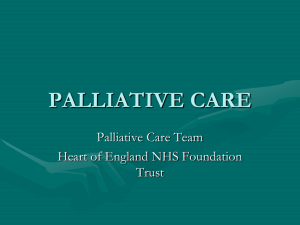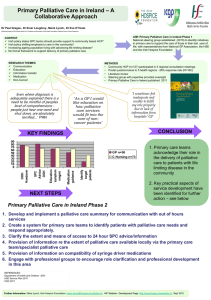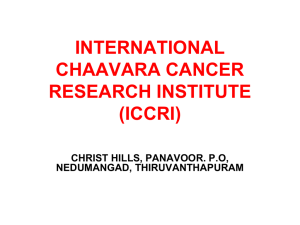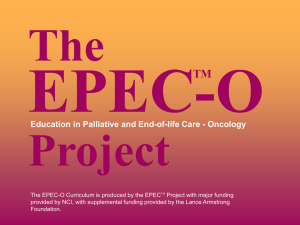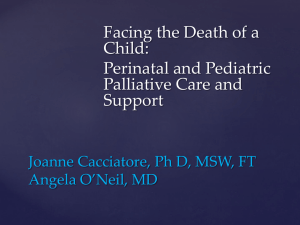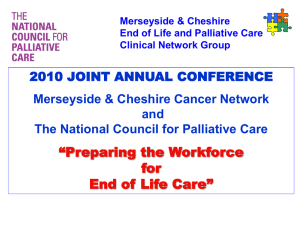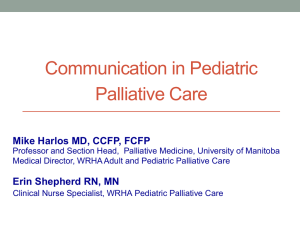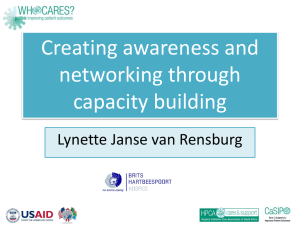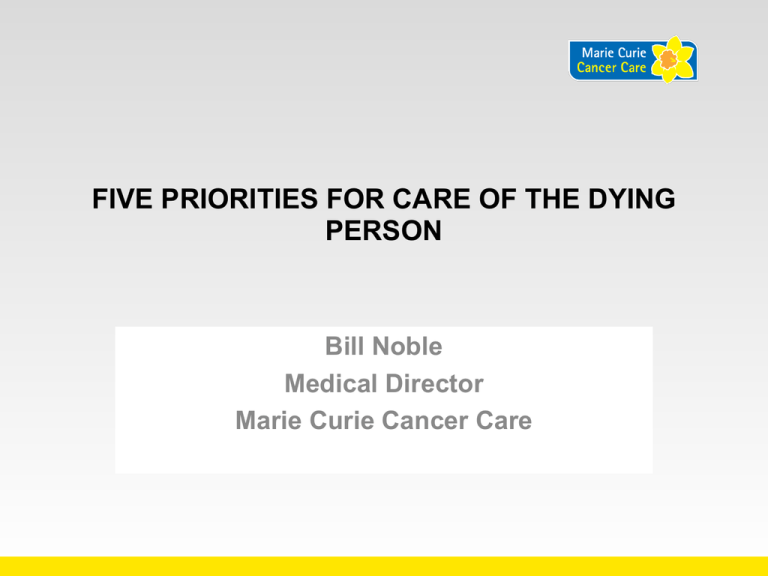
FIVE PRIORITIES FOR CARE OF THE DYING
PERSON
Bill Noble
Medical Director
Marie Curie Cancer Care
LESSONS FROM THE LIVERPOOL CARE
PATHWAY
The Neuberger Report: More care, less pathway
The Leadership Alliance
LESSONS FROM THE LIVERPOOL
CARE PATHWAY
• No dissemination without evaluation
• Industrialisation of palliative care does not work
• Documents do not an innovation make
• Doctors and nurses need family management
skills
FIVE PRIORITIES FOR CARE OF THE
DYING PERSON
1. The possibility that a person may die within the coming
days and hours is recognised and communicated clearly,
decisions about care are made in accordance with the
person's needs and wishes, and these are reviewed and
revised regularly.
2. Sensitive communication takes place between staff and the
person who is dying and those important to them.
3. The dying person, and those identified as important to
them, are involved in decisions about treatment and care.
4. The people important to the dying person are listened to
and their needs are respected.
5. Care is tailored to the individual and delivered with
compassion - with an individual care plan in place.
THE PALLIATIVE CARE
CONSULTATION
The Gold Standards Framework gave us
organisational priorities for palliative Care:
1. Identify
1. Assess
1. Plan
A 2007 NATIONAL SURVEY OF UK GENERAL
PRACTICES
2007
CARE: A NATIONAL SURVEY OF UK GENERAL
PRACTICES
Aims
To establish the extent to which UK Primary Care has adopted
recommended
practices inAND
relation
to supportive and palliative care
IMPROVING SUPPORTIVE
PALLIATIVE
of adults with cancer.
CARE FOR ADULTS WITH CANCER IN PRIMARY
To relate participation in previous initiatives, such as managed
CARE: A NATIONAL
OF UK GENERAL
frameworks
of care, SURVEY
to the adoption
of recommended practices.
PRACTICES
Methods
A random sample of 3495 GP Practices throughout the UK were sent
a postal questionnaire to complete in Spring 2007.
The senior partner was targeted, with reminders; then further
reminders were sent to Practice Managers.
Response rate
2096 completed questionnaires were returned, a response rate of
60.0%
IMPROVING SUPPORTIVE AND PALLIATIVE
CARE FOR ADULTS WITH CANCER IN PRIMARY
CARE: A NATIONAL SURVEY OF UK GENERAL PRACTICES
Comparison of the Four Nations
GSF
LCP
ACP
PPC
GP-EoLC-I
England
62.4% 27.9% 9.6%
14.4% 30.95
Scotland
80.9% 11.9% 2.1%
4.3%
32.1
Northern Ireland
27.5% 8.2%
1.4%
1.4%
29.71
Wales
16%
9.6%
8.5%
3.2%
28.54
UK mean
61.1%
24.6%
8.4%
12.3%
30.95
THE PALLIATIVE CARE
CONSULTATION
The Gold Standards Framework gave us
organisational priorities for palliative Care:
The General Practice End of Life Care Index
(GP-EoLC-I)
THE GENERAL PRACTICE END OF
LIFE CARE INDEX (GP-EOLC-I)
701 practices reported percentages of cancer patient deaths at
home or in preferred place of care
• An increased score on the GP-EoLC-PC (Personal Care)
subscale associated with an increased likelihood of
reporting cancer patient deaths at home of more than 60%,
and deaths in preferred place of care of 90% and above.
• 232 of reporting practices had taken their figures from
practice records.
• Practices using Advance Care Planning were 2.454 times
more likely to have a home cancer death rate greater than
60% compared to practices which did not.
• Practices using Preferred Place of Care were 2.173 times
more likely to have a home cancer death rate greater than
60% compared to practices which did not.
THE GENERAL PRACTICE END OF LIFE
CARE INDEX (GP-EOLC-I)
Our findings appear to support the role of national initiatives
in improving the quality of end of life care delivery in general
practice.
The analysis suggests a relationship between personal care,
opinion of quality, practice and organisation.
One possible interpretation is that adoption of the Gold
Standards Framework may help produce improved
organisation of palliative care, leading to better personal care,
and improved practice opinions of the quality of care.
However a longitudinal study or randomised trial would be
necessary in order to test for any such causal relationship.
READ CODE LOTTERY
60
Number of Patients
50
40
30
20
10
0
Frailty
Heart
Disease
Cancer
COPD
Dementia
*Other life
Stroke
limiting
illness
GSF Prognostic Indicators
Renal
disease
Parkinsons Multiple
disease
sclerosis
Motor
neurone
disease
Numbers of patients meeting each of the GSF prognostic indicators for palliative care need.
*Other life limiting illness included cystic fibrosis, Huntingtons disease, asbestosis etc.
DIVERSITY OF SURVIVAL
Survival Functions
Category
Cancer
NANC
Cancer-censored
NANC-censored
1.0
Cum Survival
0.8
0.6
0.4
0.2
0.0
0
500
1000
1500
Survival
2000
2500
GENERAL PRACTITIONER’S ROLE
IN TERMINAL ILLNESS
Flexibility, patient centredness and public health
perspective
Culture of frequent review, 24 hour clinical
responsibility and rapid escalation.
UK PALLIATIVE CARE SERVICES
HELP THE HOSPICES 2013
• 220 hospice and palliative care inpatient units
• 3,175 hospice and palliative care beds
• 288 home care services
• 127 hospice at home services
• 272 day hospice units
• 343 hospital support services
NUFFIELD TRUST REPORT ON
MARIE CURIE NURSING SERVICE
A report from the Nuffield Trust indicates the
potential savings which can be achieved by
delivering community based end of life care.
In 2012, the Nuffield Trust published its evaluation
of the Marie Curie Nursing Service (MCNS). It
compared the experiences of almost 30,000 people
who had received MCNS care with matched
controls who were alike in every respect that could
be measured, other than they had not received
MCNS care.
NUFFIELD TRUST REPORT ON
MARIE CURIE NURSING SERVICE
The study found that access to MCNS care had a
profound impact for those at the end of life.
Put simply, those who received the service were
significantly more likely to die at home and were
much less likely to use all forms of hospital care in
the last few months of life.
The result was that total hospital costs for people
using the Marie Curie Nursing Service were £1,140
less per person.
EXPLORING THE COST OF CARE AT
THE END OF LIFE
Its conclusion is clear:
“any increase in activity that might occur in primary
care, community care and in social care activity as
a result of reduced hospital bed days is likely to be
very modest when considered against the entirety
of care activity during the last months of life.”
Based on these calculations it is estimated that
commissioners could be able to realise potential
savings of ‘nearly £500 per person’.
LESSONS FROM A STUDY OF AN
INNOVATIVE CONSULTANT-LED
COMMUNITY SERVICE IN THE UK
• The Midhurst Macmillan Specialist Palliative Care Service
(MMSPCS) is a UK, medical consultant-led, multidisciplinary team
aiming to provide round-the-clock advice and care, including
specialist interventions, in the home, community hospitals and
care homes.
• Of 389 referrals in 2010/11, about 85% were for cancer, from a
population of about 155 000. The mean cost is about 3000 GBP
(3461 EUR) per patient with mean cost of interventions for cancer
patients in the last year of life 1900 GBP (2192 EUR). Post-referral,
overall costs to the system are similar for MMSPCS and hospiceled models; however, earlier referral avoided around 20% of total
costs in the last year of life.
• Patients and carers reported positive experiences of support,
linked to the flexible way the service worked. Seventy-one per cent
of patients died at home. This model may have application
elsewhere.
FIVE PRIORITIES FOR CARE OF THE
DYING PERSON
1. The possibility that a person may die within the coming
days and hours is recognised and communicated clearly,
decisions about care are made in accordance with the
person's needs and wishes, and these are reviewed and
revised regularly.
2. Sensitive communication takes place between staff and the
person who is dying and those important to them.
3. The dying person, and those identified as important to
them, are involved in decisions about treatment and care.
4. The people important to the dying person are listened to
and their needs are respected.
5. Care is tailored to the individual and delivered with
compassion - with an individual care plan in place.
THE PALLIATIVE CARE
CONSULTATION
The Gold Standards Framework gave us
organisational priorities for palliative Care:
1. Identify
1. Assess
1. Plan
THE PALLIATIVE CARE
CONSULTATION
The Gold Standards Framework gave us
organisational priorities for palliative Care:
Low scores for carer support and information
CONTEXT, ISSUES, STORY, PLAN.
The points of agreement or concordance, need to cover
all four key areas; missing any of them has grave
consequences for the clinical relationship.
Without concordance, patients might
conclude that:
you don’t know why you are there (context)
you don’t know what’s the matter (issues)
you don’t know what’s going on (story)
you don’t know what you’re doing (plan).
CONTEXT, ISSUES, STORY, PLAN.
Four points in the encounter where doctor and
patient with or without family or carers, need to be
in agreement:
Context: Why you are seeing the patient and or the
family today, your relationship
Issues: Concerns, diagnoses, symptoms, feelings,
fears, problems
Story: How the disease or illness relates the patients
life and family.
Plan: Information, investigations, treatment, care,
escalation, review, availability, safety-net

